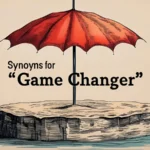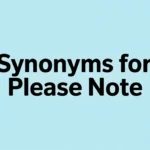In professional communication, especially through email, clarity and tone are paramount. Sometimes, when you’re following up or revisiting a previous conversation, the phrase “circling back” is often used. However, this phrase can feel overused or might not always come across as professional as you’d like. Other Ways to Say “Circling Back”.
Fortunately, there are various ways to communicate the same message without sounding repetitive. Whether you’re sending a reminder, revisiting an unresolved issue, or continuing a discussion, it’s important to use alternatives that sound fresh, respectful, and direct.
This article will explore several alternatives to the phrase “circling back” in an email. Each suggestion will be highlighted with context, making it easier for you to choose the most appropriate phrase depending on the situation. Keep reading for alternative phrases that can help elevate your email communication.
Revisiting Our Previous Discussion
When you want to touch base on a past conversation, “revisiting our previous discussion” serves as a polite alternative. This phrase gently reminds the recipient of an earlier conversation without over-complicating the language. It implies that you are bringing up something from the past, but with a focus on moving forward. This phrasing works well in professional emails, especially when discussing ongoing projects, unresolved issues, or topics that need follow-up. For example, “I am revisiting our previous discussion regarding the upcoming project deadlines” serves to directly address the matter at hand. It offers clarity and maintains a tone of professionalism, keeping the focus on what was previously talked about, while emphasizing the need to continue the conversation.
Read More: Other Ways to Say “FYI”
Following Up on Our Last Exchange
“Following up on our last exchange” is a great alternative to “circling back.” It directly states that you’re continuing from where you left off without using overly casual language. This phrase can be especially helpful when you’ve had a prior conversation or meeting and need to keep the momentum going. It also implies that the email serves as a reminder or prompt for further action or clarification. For instance, in a situation where a decision hasn’t been made yet, you could write, “Following up on our last exchange, I wanted to know if you’ve had a chance to review the proposal.” This keeps the message clear, concise, and focused on ensuring the previous discussion is followed through.
Returning to Our Earlier Conversation
If you need to bring attention to an issue or conversation that was paused, “returning to our earlier conversation” provides a formal and respectful way to address it. This phrase is useful when you want to show that you haven’t forgotten the matter and that it’s still important to address. It offers a sense of continuity, showing that you are picking up right where things were left off. For example, “I’m returning to our earlier conversation about the marketing strategy for next quarter,” can be a clear and effective way to bring the matter to the forefront without being repetitive. It’s professional and respectful, perfect for a corporate or formal email.
Touching Base Again
“Touching base again” is an excellent way to offer a more relaxed but still professional alternative to “circling back.” It’s an informal phrase that works well when you’ve had previous communications and want to check in for an update. It’s light, approachable, and keeps the tone friendly. For example, in the context of a follow-up email, you might say, “Just touching base again to see if you’ve received my last email regarding the presentation.” This approach keeps the conversation open without being overly formal or rigid. It’s also an effective way to show you’re on top of things without sounding too pushy.
Checking In on Our Last Discussion
Using “checking in on our last discussion” is a simple and clear alternative. This phrase allows you to check in on the status of something previously discussed, be it a project, idea, or action item. It implies that you’re actively engaged with the matter at hand and are seeking a response or update. For instance, you could say, “Checking in on our last discussion about the upcoming deadlines,” which invites the recipient to provide an update or share their progress. It maintains a polite, friendly tone and shows that you’re interested in moving the conversation forward.
Following Up for Clarity
If you need to clarify something discussed in a prior conversation, “following up for clarity” is a suitable phrase. This works well when there are still unresolved details or misunderstandings that need addressing. It indicates that you’re not only revisiting the topic but also seeking to make things clearer. For example, “Following up for clarity on the project timeline, I wanted to confirm if the dates are still accurate” is a great way to approach the situation. It’s specific and precise, showing you’re invested in getting things straightened out.
Bringing Up a Previous Matter
“Bringing up a previous matter” is a useful and formal alternative when you want to reintroduce a topic that requires further attention. It’s direct and clear, making it a good option when you need to highlight an unresolved issue or follow up on a pending action. It shows you are serious about getting the matter addressed. For example, “I am bringing up a previous matter concerning the budget approval process” provides a clear introduction to the topic without the overused “circling back.”
Reaching Out About Something We Discussed
If you want a casual but still professional tone, “reaching out about something we discussed” is another solid option. This phrase is useful for reconnecting with a colleague or client about a topic you’ve discussed earlier. It sounds approachable and shows you are taking the initiative to ensure things are moving forward. For instance, “Reaching out about something we discussed in our last meeting, I wanted to check if there are any updates on your side” is an excellent way to continue a conversation without sounding too stiff.
Revisiting a Previous Topic
“Revisiting a previous topic” serves as an alternative when you’re bringing up an issue or discussion from the past that still requires attention. It’s slightly more formal than some other phrases but is still effective when used in professional communication. It suggests that you’re not forgetting the topic but are bringing it up again to ensure things are addressed. For example, “I’m revisiting a previous topic regarding the quarterly report submission” is an excellent way to keep the conversation flowing.
Re-engaging on Our Earlier Conversation
When you want to show you’re reigniting a discussion, “re-engaging on our earlier conversation” works well. This phrase is perfect for situations where the conversation has slowed down, and you need to reignite interest or action. For instance, “I’m re-engaging on our earlier conversation about the new software update” signals your intent to get the ball rolling again. It’s clear, polite, and shows that you’re serious about making progress.
Bringing This Topic Back to the Forefront
If you want to emphasize the importance of revisiting a matter, “bringing this topic back to the forefront” works well. It shows urgency and indicates that the subject is significant and worth discussing again. For example, “Bringing this topic back to the forefront, I wanted to follow up on the recent meeting outcomes” places importance on the issue without sounding demanding. It’s a great way to ensure your message stands out while keeping a professional tone.
Revisiting Our Earlier Thoughts
“Revisiting our earlier thoughts” works well when you want to emphasize that you’re reflecting on prior ideas or concepts. This can be helpful in brainstorming scenarios or when you need to discuss options that were previously considered. For instance, “Revisiting our earlier thoughts about the design direction, I think we can move forward with a few tweaks” brings the conversation back in a positive, solution-oriented way. It shows that you value previous input while progressing the discussion.
Checking Back In
A short and sweet alternative, “checking back in” is a friendly way to say you’re following up. This phrase is especially useful for checking in on an update, confirmation, or reply that’s expected. For instance, “Just checking back in to see if there are any updates on the proposal” allows you to maintain momentum without sounding too formal. It’s simple, to the point, and professional.
Requesting an Update
If you’re seeking new information, “requesting an update” is a more straightforward option. This phrase is direct and respectful, making it clear you’re looking for progress or new developments. For example, “I’m requesting an update on the status of the action items we discussed last week” is clear and polite, with no ambiguity. It ensures the recipient knows exactly what you are looking for.
Following Up on Previous Correspondence
“Following up on previous correspondence” is another formal and professional way to reintroduce a topic. It conveys that you are continuing a conversation that was initiated earlier. This phrase is particularly useful in formal emails where you want to emphasize the continuation of a specific thread or discussion. For example, “Following up on previous correspondence, I wanted to see if you had any further thoughts on the proposal.” This phrase works well in situations where the conversation may have gone dormant for a while, signaling your intent to re-engage without sounding repetitive.
Reaffirming Our Previous Conversation
When you need to bring up a topic again and provide further context or a prompt, “reaffirming our previous conversation” can be an excellent alternative. It subtly conveys that you are echoing what was previously discussed, adding weight to the conversation’s importance. For instance, “I’m reaffirming our previous conversation about the project timeline to ensure we’re on the same page” makes it clear that you are revisiting the subject matter with purpose. It works well when you need to clarify any points or ensure alignment moving forward.
Following Up with Additional Information
If you want to include more details or provide updates after a previous conversation, “following up with additional information” can be a helpful alternative to “circling back.” This phrase is useful when you need to continue the dialogue by introducing new insights or resources. For example, “Following up with additional information, I’ve attached the revised budget for your review” keeps the tone professional and ensures that you’re contributing meaningful details. It adds value to the follow-up, signaling that you’re not just revisiting the topic, but also offering something new.
Continuing Our Conversation
“Continuing our conversation” is another effective phrase to keep the tone light and professional. It conveys that the topic is still under discussion, and you are maintaining the flow of communication. It’s less formal than other alternatives and works well in less structured email exchanges. For example, “Continuing our conversation about the marketing plan, I wanted to confirm the next steps” encourages the recipient to pick up where the conversation left off. This phrase keeps the email conversational while still reinforcing the need for ongoing communication.
Checking in Regarding Our Earlier Discussion
“Checking in regarding our earlier discussion” serves as another option when you need to follow up on something previously discussed. It’s clear and polite, signaling that you’re still invested in the matter and looking for progress. For instance, “Checking in regarding our earlier discussion about the upcoming event, I wanted to make sure everything is on track” is a simple, yet effective way to maintain communication. It’s respectful and maintains a professional tone while inviting a response.
Seeking an Update on Our Previous Topic
If you are looking for an update on a matter that was previously discussed, “seeking an update on our previous topic” is a straightforward and respectful way to phrase your request. This option works well when you’re looking for specific updates or resolutions. For example, “Seeking an update on our previous topic of discussion, I would appreciate any insights you have on the current status” is clear and to the point. It shows that you’re actively engaged and looking for the next steps. It’s a great option when you want to sound assertive without being too forceful.
Conclusion
Finding the right alternatives to “circling back” can improve the tone and clarity of your email communication. By using phrases like “revisiting our previous discussion,” “touching base again,” or “requesting an update,” you can ensure your emails sound more professional and fresh. It’s all about keeping your communication clear and concise while maintaining a polite and respectful tone.
Whether you’re following up on a project, seeking clarification, or re-engaging on a previous conversation, these alternatives offer diverse options to fit any situation. By incorporating these phrases, you can make your email exchanges more effective, engaging, and professional.

Ashley Bennett, a language enthusiast at WordSeekerz.com, simplifies English grammar and vocabulary with a fun, engaging approach. She helps readers expand their vocabulary, improve writing, and master synonyms effortlessly. Explore more at WordSeekerz.com!










